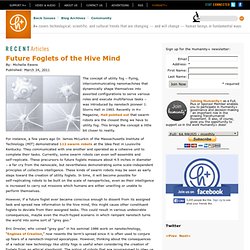

Spinning Spare Parts. Clean crochet: A specialist weaves a blood vessel graft from human threads on a sterile tubular loom.

Thin off-white threads of human cellular material spiral around the spindle of a machine that is braiding them into a sturdy rope. It sounds macabre, but the inspiration for the material, made by San Francisco–based Cytograft Tissue Engineering, is health, not horror: the biological strands could be used to weave blood vessel patches and grafts that a patient’s body would readily accept for wound repair. The process is faster and could be more cost-effective than other methods of producing biological tissue replacements. Nanomedicine Art Gallery - Exhibit List. Utility Fog. Utility fog. Visualization of foglet with arms retracted and extended Diagram of a 100-micrometer foglet Utility fog (coined by Dr.

John Storrs Hall in 1993[1]) is a hypothetical collection of tiny robots that can replicate a physical structure.[2][3][4][5] As such, it is a form of self-reconfiguring modular robotics. Conception[edit] Hall thought of it as a nanotechnological replacement for car seatbelts. In the original application as a replacement for seatbelts, the swarm of robots would be widely spread-out, and the arms loose, allowing air flow between them. Hall and his correspondents soon realised that utility fog could be manufactured en masse to occupy the entire atmosphere of a planet and replace any physical instrumentality necessary to human life. See also[edit] References[edit] External links[edit] Utility Fog at Nanotech Now, many links. Magnetic levitation. Magnetic levitation, maglev, or magnetic suspension is a method by which an object is suspended with no support other than magnetic fields.

Magnetic pressure is used to counteract the effects of the gravitational and any other accelerations. Earnshaw's theorem proves that using only ferromagnetic or paramagnetic materials it is impossible to stably levitate against gravity; however, servomechanisms, the use of diamagnetic materials, superconduction, or systems involving eddy currents allow to achieve that. In some cases the lifting force is provided by magnetic levitation, but there is a mechanical support bearing little load that provides stability. This is termed pseudo-levitation. Magnetic levitation is used for maglev trains, magnetic bearings and for product display purposes. Lift[edit] where Stability[edit] Static[edit] Static stability means that any small displacement away from a stable equilibrium causes a net force to push it back to the equilibrium point. The KnowhowCompany: Foglets! Are they still a concept? Covering technological, scientific, and cultural trends that are changing human beings in fundamental ways.
Michelle Ewens March 24, 2011 The concept of utility fog – flying, intercommunicating nanomachines that dynamically shape themselves into assorted configurations to serve various roles and execute multifarious tasks – was introduced by nanotech pioneer J.

Storrs Hall in 1993. Recently in H+ Magazine, Hall pointed out that swarm robots are the closest thing we have to utility fog. This brings the concept a little bit closer to reality. For instance, a few years ago Dr. However, if a future foglet ever became conscious enough to dissent from its assigned task and spread new information to the hive mind, this might cause other constituent foglets to deviate from their assigned tasks. Eric Drexler, who coined “grey goo” in his seminal 1986 work on nanotechnology, “Engines of Creation,” now resents the term’s spread since it is often used to conjure up fears of a nanotech-inspired apocalypse. What Is It Like to Be a Foglet? The Psychology of Groupthink The Ethics of Military Foglets. Utility fog. Report on Nanobots (Nanotechnology Robots) Here Come The Nanobots. A team of New York University researchers has taken a major step in building a more robust, controllable machine from DNA, the genetic material of all living organisms.

Constructed from synthetic DNA molecules, the device improves upon previously developed nano-scale DNA devices because it allows for better-controlled movement within larger DNA constructs. The researchers say that the new device may help build the foundation for the development of sophisticated machines at a molecular scale, ultimately evolving to the development of nano-robots that might some day build new molecules, computer circuits or fight infectious diseases. The research team was led by NYU chemistry professor Nadrian C. Seeman.